The “two sessions” of the Political Consultative Conference and the National People’s Congress will begin on Monday and Tuesday next week. We will closely observe the conflicting goals in Chinese politics that the central planning document must resolve this year. Christiane Kuehl kicks things off with a report on the difficult decision of which is the better recipient of state subsidies: the coal industry or renewable energy sources.
Chinese politics generally have a harder time today than during the boom. High growth masks many problems and spares making difficult decisions. Instead of having to choose between two goals, both were often promoted and pursued. Since the real estate bubble popped, however, there are no longer enough resources for such generosity. China’s leadership faces the realities of a large economy.
Just how difficult the decisions are now is demonstrated by the CCP entering the People’s Congress without its Central Committee convening the third plenum. Normally, this meeting sets the guidelines for economic policy at a centralized level. It should have taken place late last fall, but it never happened. Instead, this year’s plans are derived directly from Xi Jinping’s own plans.
Over the past five years, Ursula von der Leyen has made a name for herself as Beijing’s trade policy rival, which she accuses of unfair practices. Next week, the political parties in the European Parliament plan to re-nominate her as their lead candidate at their congress in Bucharest. Amelie Richter retraces the evolution of her China policy.

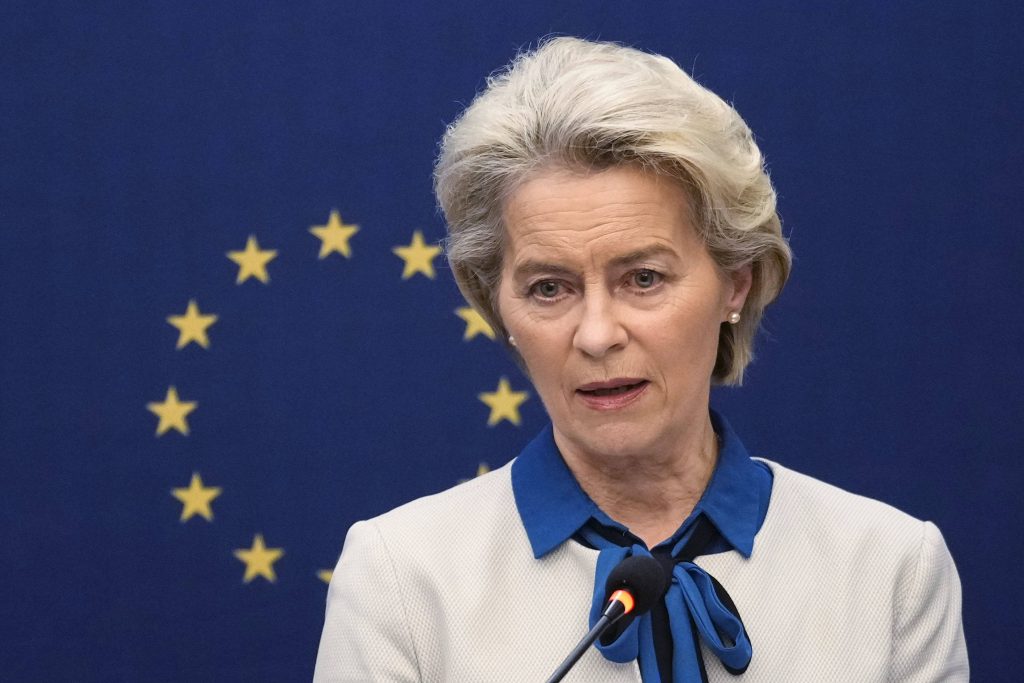
EU Commission President Ursula von der Leyen is expected to be the Christian Democratic EPP’s candidate for the European elections in June. She intends to have her candidature confirmed in Bucharest next week. Von der Leyen’s de-risking approach has been a defining feature of EU-China relations since 2019, and she intends to continue this program in a possible second term of office.
She has already left her mark on the discussion surrounding the European and German China strategy during her first term of office. “This is the geopolitical Commission that I have in mind, and that Europe urgently needs,” von der Leyen emphasized during the presentation of her program in the EU Parliament in November 2019.
According to Marc Julienne, Director of the Asia department at the French think tank l’Institut français des relations internationales (Ifri) Table.Media, von der Leyen has generally made the right choice with this geopolitical approach. The events of the last five years surrounding the Covid pandemic and the attack on Ukraine have proven her right in her approach, says Julienne.
However, von der Leyen’s approach has “triggered mixed feelings” in the French capital. On the one hand, the concept of risk reduction with regard to China is welcomed there. On the other hand, von der Leyen is considered too US-aligned in Paris, which is traditionally rather Washington-skeptical, says Julienne.
A new chapter is now on the horizon: The US elections this fall. However, the future of the transatlantic coordination on China will only partially depend on the outcome of the US elections, explains Noah Barkin from Rhodium Group and the Berlin office of the German Marshall Fund. “If Donald Trump returns to the White House and starts a trade conflict with Europe, then it is more difficult to envision close collaboration between Washington and Brussels on China.” Barkin is certain, however, that a possible US President Trump will not lead to a significant change in Europe’s approach to China.
“As a former German defense minister, she saw the relationship with China through a security prism from the beginning,” Barkin emphasizes. This is evident, for example, in the Comprehensive Agreement on Investment. The Commission President was “not a fan” of it, and she did not openly express her support for the agreement. Most of the negotiations were held under Jean-Claude Juncker’s previous Commission.
However, von der Leyen did not only inherit the disliked CAI from Juncker but also the now widely known triad of partner, competitor and rival. The Juncker Commission presented this as its China strategy in March 2019. The CAI now seems like a distant memory, somewhere at the back of the EU’s historical mind – while the classification as competitor and rival has shifted more into focus.
Brussels has significantly expanded the EU economy’s defensive capabilities since 2019. The EU has repeatedly made advances that have provoked Beijing’s ire. One example is the planned tariffs on Chinese electric cars, which China considers to be an unfriendly act. Von der Leyen believes they are a necessary means of preventing export dumping. The planned Carbon Border Adjustment Mechanism (CBAM) and the Anti-Coercion Instrument are also a thorn in Beijing’s side.
The brewing friction between the two sides has also been reflected in the recent exchange between Brussels and Beijing, after the Covid-19 pandemic further complicated it: There was no EU-China summit in 2021, because of the rampant coronavirus. In the following year, the format was held in the form of a video call.
Under the shock of the start of the war against Ukraine, Brussels had one issue above all on its list: To win over Beijing as a voice of reason that could influence Moscow. China didn’t want to hear much about this and only wanted to talk trade. The online summit turned out to be a disaster. Both sides seemed ill-prepared for the concerns of the other.
2023 was a decisive year for EU relations under von der Leyen: At the end of March, she was the first Commission President to hold a keynote speech on China, coining the de-risking motto in Brussels. During her visit with Macron in Beijing just a few days later in April, she persisted in her confrontational approach. In December, the first in-person EU-China summit was held in Beijing. Von der Leyen spoke with China’s President Xi Jinping for several hours.
Steven Blockmans, Director of Research at the Brussels-based think tank Centre for European Policy Studies (CEPS), already sees a direction for von der Leyen’s second term in office: “Tensions between China and the EU are bound to rise,” says Blockmans. This will lead the next Commission to put the emphasis in the EU’s approach to the PRC even more on systemic rivalry.
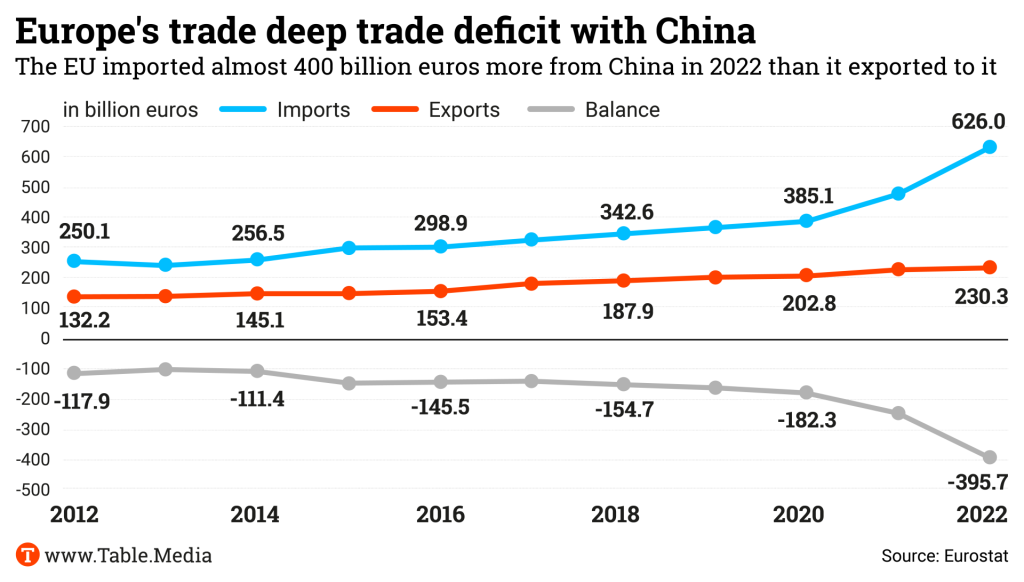
After five years, the EU Commission President has laid the foundations for the geopolitical Commission – but there are still unresolved issues:
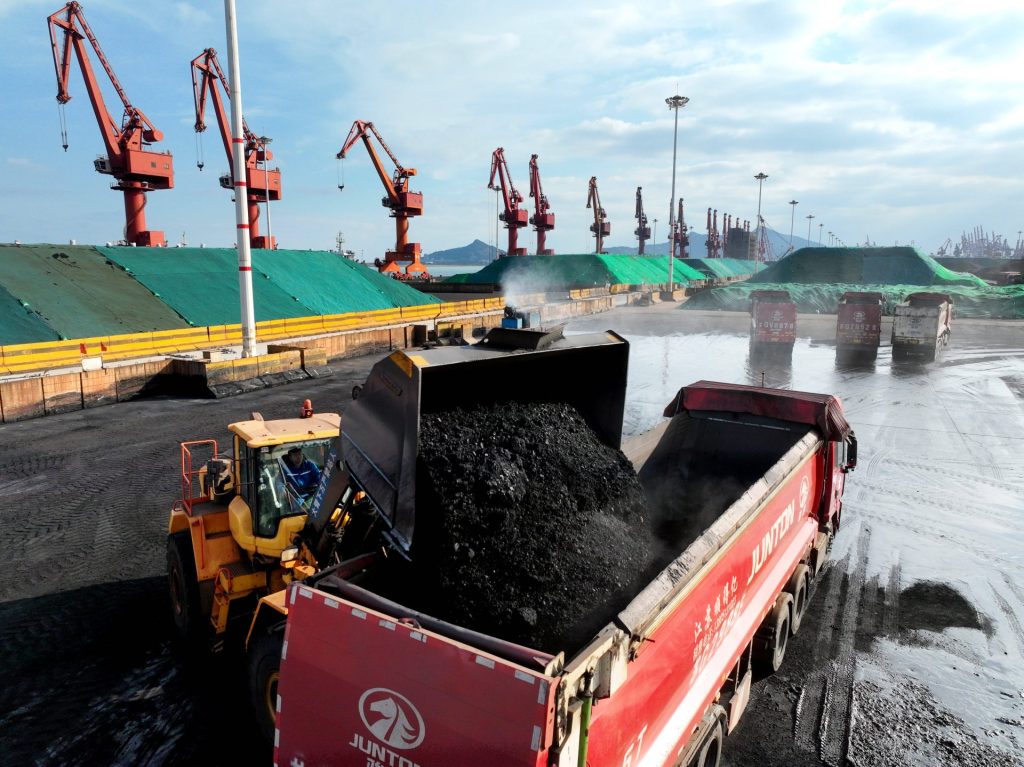
In China, the clashing goals of resolute climate action and the continuing hunger for coal are coming to a head. Last year, the People’s Republic deviated from its carbon targets for the first time in years – partly because coal consumption rose by 4.4 percent in 2023.
The complex issues of climate action and energy security will be discussed at the National People’s Congress meeting starting next Tuesday (March 5). After all, both are very high on the priority list of state and party leader Xi Jinping. The NPC is expected to make a clear commitment to expanding renewables, as these are an important driver of growth. However, it is unclear how much the coal industry will be allowed to grow in parallel.
On the one hand, Xi’s efforts to tackle climate change seem ineffective. According to a new study, China’s emissions increased by a whopping 12 percent between 2020 and 2023 due to growing coal consumption. According to Reuters, China approved coal-fired power plants nationwide with a total capacity of 114 gigawatts (GW) in 2023, 10 percent more than in 2022.
On the other hand, China is adding more renewable energy capacity than any other country in the world. According to the National Energy Agency (NEA), China connected more plants to the grid in 2023 than ever before: 216.9 gigawatts (GW) of new solar capacity – more than the total installed capacity of the EU at the end of 2022 – and 75.9 GW of new wind power plants.
This has created a booming new economic sector that competes directly with the state giants in the fossil fuel industries – for state money and benefits. “The conflict of interest between the old and new industries will intensify in climate policy over the next few years,” Nis Gruenberg from the think tank Merics expects. “How the government resolves this conflict will be the decisive joker, as it is for us.”
The state-owned companies in traditional industries continue to invest a lot of money in fossil fuels, Gruenberg told Table.Media. “The big energy companies such as PetroChina or CNOOC are huge socio-economic systems with one to two million connected employees.” The well-being of these giants, which are important for stability, has so far depended on the use of fossil fuels.
However, all parties involved know that they are facing a massive transformation. China’s industry must be “quickly and expensively converted to green energies,” says Gruenberg. For instance, China wants to power steel blast furnaces with hydrogen in the medium term.
And so there are first signs that the coal boom is ending – for example, in the provincial work reports for the NPC. China’s four largest coal hubs, where more than 80 percent of production is concentrated, have no longer issued ambitious targets for higher coal production.
According to Bloomberg, their efforts focus instead “on supporting China’s explosive growth in renewables.” China’s number one coal province, Shanxi, has lowered its annual coal consumption target from over 100 million tons in 2022 to 57 million tons. The provincial government also intends to advance the installation of solar systems on large areas that have become too polluted for agriculture or residential areas due to mining activities.
In line with its self-imposed climate targets, China aims to reach its coal consumption peak in 2025. As a result, growth in coal production could slow to 1.4 percent in 2024, Bloomberg quoted a Guosheng Securities report. This would be the lowest growth since 2017. The current coal boom began after 2017.
However, the plan is not to switch off fossil fuel capacities until the new system of renewable energies and electricity storage is fully operational. “We want to have everything competitive enough to phase out fossil fuels, through the market process. Not command and control,” said government advisor Pan Jiahua in a recent Carbon Brief interview.
In the interview, Pan, vice-chair of the national expert panel on climate change of China, expressed a clear opinion on energy sources: “Fossil fuels are fossils. They are a thing of the past.” Pan called constructing coal-fired power plants and other fossil fuel infrastructure a “waste of money.” Not so with renewables. “Renewables would not require a huge amount of investment in infrastructure.”
“The cleantech sector – i.e., renewable energies or electric cars – has now become a very large industrial sector, accounting for around ten percent of industrial production,” says Nis Gruenberg. “This sector is a growth engine and is now systemically relevant – for China’s economic growth and China as a business location.” Given the massive investments, this will remain the case. So, it is unlikely that this sector will be pushed aside at the NPC. What is more uncertain is how the party leadership will position itself on coal.
The big five electricity producers have a double interest in all of this. “They practically all operate coal-fired power plants and don’t want to lose their investments here,” says Gruenberg. “At the same time, they are also investing in huge solar and wind farms – and are benefiting from subsidies and the rapid development of the sector. These companies are making a clear cost-benefit analysis: As soon as state subsidies for coal are removed, they will transition even faster. The fossil fuel lobby is very heterogeneous. The direction in which it moves is hanging in the balance.”
And politicians will decide on this next week. A new study by the Oxford Institute for Energy Studies (OIES) found that stricter and more specific targets were set in various important environmental and energy policy areas in the second half of 2023. Beijing urges more haste with existing targets. The fact that phrases such as “reducing carbon emissions, reducing pollution, green development, and economic growth” are once again appearing more frequently indicates that these priorities have increased for 2024. The NPC could show whether this is truly the case.
The deal is sealed: Volkswagen and the Chinese EV manufacturer XPeng have concluded negotiations on their future collaboration and signed a cooperation agreement. The two manufacturers will jointly develop electric cars. Two battery-powered models in the compact class are already planned.
In July, Volkswagen secured a five percent stake in XPeng with an investment of 700 million euros. The now finalized cooperation agreement includes the reciprocal use of vehicle and platform parts. The aim is to reduce development costs and achieve “significant synergies.”
The companies want to pool their purchasing activities and jointly develop cars to ensure that new models can be brought to market a third faster. “In the world’s largest and fastest growing EV market, speed is fundamental when it comes to tapping into promising market segments,” said Ralf Brandstaetter, Board Member of Volkswagen AG for China, explaining the move. XPeng CEO Xiaopeng He praised the trusting collaboration in exploring the terms of cooperation.
After Volkswagen’s ID models performed poorly in the Chinese market, the company is now focusing on an ‘In China, for China’ approach to better appeal to Chinese customers. To this end, the Volkswagen Group China Technology Company (VCTC), the Group’s largest development center outside Germany, was founded at the Hefei site. VCTC and XPeng will work together on the new models. jul/rtr
The US government investigates Chinese cars for potential security risks. The White House announced that the focus is on whether the vehicles collect and transmit sensitive data to China. Modern car driver assistance systems use a variety of cameras and sensors. The US government fears that the data collected could fall into the wrong hands.
The Chinese Ministry of Foreign Affairs did not initially issue a statement. Cui Dongsho, Secretary General of the China Passenger Car Association, explained that considering all cars equipped with smart sensors, it would be unfair to target cars from a specific country and impose restrictions.
The USA largely prevents Chinese vehicles from entering its market, partly through high import tariffs. However, Secretary of Commerce Gina Raimondo stated that the government intends to react before the cars are widely available. The US has already targeted Chinese telecommunications companies in the past and labeled Huawei and ZTE as a national security threat. rtr
The US government has banned the transfer of genetic data to China and a number of other countries. The executive order issued by President Joe Biden on Wednesday also prohibits the mass transfer of other sensitive information of US citizens, including geographic, biometric, health and financial data. “Buying data through data brokers is currently legal in the United States, and that reflects a gap in our national security toolkit,” said senior government officials. This represents a security gap. “Countries of concern, such as China and Russia, are buying American’s sensitive personal data from data brokers.”
Experts believe the president’s executive order is aimed at companies such as the Chinese BGI Group. The genetics company is building the China National GeneBank, a state archive containing genetic data on millions of people – not only from China but also from other countries around the world. In 2022, the Pentagon added BGI to a list of companies allegedly working with Beijing’s military back in 2022.
Peter Harrell, a former US National Security Council member, says such data is “extremely high risk” and that there is “little need for that to be processed in China.” BGI, on the other hand, stated that it would respect data privacy and refuse to be driven out of the US market. jul/rtr
Due to forced labor concerns, parts of the international solar supply chain have shifted from China to other countries. For example, polysilicon manufacturers like Wacker in Germany, Hemlock Semiconductor from the US and OCI Malaysia have all increased their deliveries of this solar cell and semiconductor raw material to Vietnam, according to polysilicon market specialist Bernreuter Research on Wednesday. Wacker, Hemlock and OCI Malaysia increased their polysilicon exports to Vietnam by a combined 78 percent to 33,265 tons in 2023.
According to Bernreuter Research, its customers include three of the four largest Chinese solar module suppliers, which have been operating wafer factories in Vietnam for some time: JA Solar, Jinko Solar and Trina Solar. By operating wafer production facilities outside the People’s Republic, China’s manufacturers attempt to circumvent the US import ban on goods from Xinjiang, where forced labor is suspected to take place. Modules bound for the United States must not have any metallurgical silicon or polysilicon from Xinjiang in their supply chain. This is easier to prove at a site in Vietnam.
However, as Bernreuter Research reports, customs statistics show that polysilicon exports from China to Vietnam have skyrocketed from 639 tonnes in 2022 to 4,970 tonnes in 2023. Bernreuter Research said this “raises doubts about the claims of a separate supply chain.”
Conversely, China’s polysilicon imports fell to their lowest level since 2011. Bernreuter Research cites Chinese customs data showing that China’s imports fell by 28.5 percent to 62,965 tonnes in 2023 – even 2,000 tons below the 2011 level. Wacker and OCI Malaysia, in particular, continue to enjoy good business with China. Together, both companies hold a 98 percent market share of polysilicon imports in China. Although China produces large quantities of polysilicon itself, it also requires raw material imports. ck
The EU, Canada, the US and the UK have expressed grave concern over the draft version of a separate security law for Hong Kong. “We are particularly concerned by Hong Kong authorities’ proposal to adopt broad and vague definitions of ‘state secrets’ and ‘external interference’ that could be used to eliminate dissent through the fear of arrest and detention,” reads a press statement from the US Department of State in Washington on Wednesday. The UK’s Foreign Secretary David Cameron fears even more human rights violations. The EU member states plan to present their objections to the Hong Kong government by Friday.
The Hong Kong National Security Law eradicated the freedoms of the southern Chinese metropolis in 2020, despite China having guaranteed them for several decades. The National People’s Congress, i.e. the Chinese parliament, had passed this law. It thus applies to Hong Kong because although Hong Kong is a Special Administrative Region, it is ultimately part of the People’s Republic.
The new legislation is now a project of the pro-Beijing Hong Kong city government and will be passed by the city parliament. This means that the national law with special validity for Hong Kong will now be supplemented by a local law with very similar intentions. This time, the focus is more on the activities of foreigners. Once the law comes into force, the international community in Hong Kong will become more liable to prosecution, for example, for conducting investigations or making political statements.
The government had gathered opinions from business and society until Wednesday. The law is expected to be passed quickly. The existing security law has already largely neutralized the political opposition in the city. fin

Apart from the crispy Peking duck and the food in general, the People’s Republic has two other big “P” up its sleeve: Ping pong and pandas. Often declared dead, both have been image mainstays for decades and are almost the only guarantors of Beijing’s international soft power.
In South Korea’s Busan, China’s ping pong stars have just steamrolled their opponents once again. And rumors that China will no longer allow its pandas to leave the country are fake news: Beijing has refueled its lending carousel for giant pandas and is continuing to turn it at full speed.
In the spring of 2015, a secret Party dossier was openly on sale at a book stall at Beijing’s Panjiayuan flea market. The vendor only wanted 20 yuan for it. As a correspondent, I generally steered clear of internal documents as their possession could be considered espionage.
On 23 January 1965, the Central Committee Ministry of Propaganda had distributed this booklet marked with a warning 机密 as classified material. It was not the age but the mysterious title that I could not resist: “How do you play ping pong?”
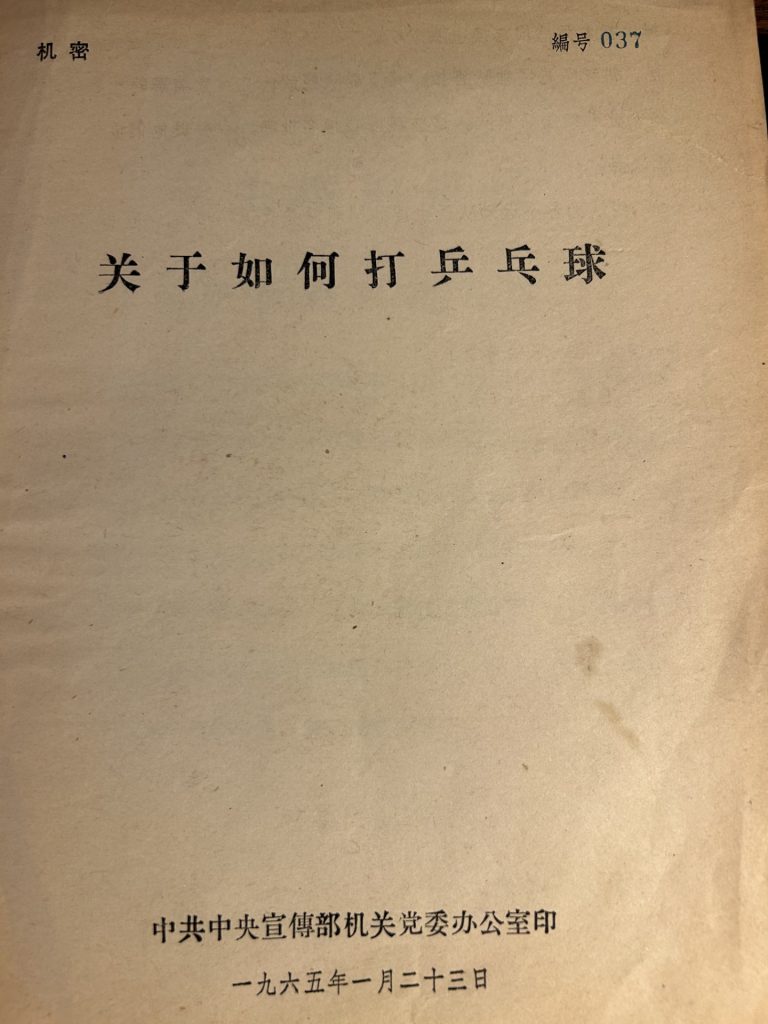
I found the answer to this rather bizarre question for a party document on page two in the form of Chairman Mao’s commentary. He wrote it on 12 January 1965 and its content was even more puzzling. Mao demanded that two attached speeches on table tennis be sent to the highest CC comrades and then to the people because they were of utmost importance. One of the letters was from China’s legendary Marshal He Long, who headed the Sports Commission at the time. He urged everyone to thoroughly study the second lecture by ping pong star Xu Yinsheng (徐寅生).
Xu was a gold medalist in 1963. In a long speech, he taught China’s women’s team, which only finished third at the World Table Tennis Championships in Prague, how to win against foreign countries. “First of all, we have to know who we are playing for and how we are playing.” And who the opponent is.
The women should learn from the People’s Liberation Army, who always envision an enemy in mind during training. “I think if we visualize the ping-pong ball as Chiang Kai-shek’s head, we can make every strike even more powerful.” (解放军是带着敌情观念练兵的,我也想如果我们把乒乓球看作蒋介石的脑袋,一板一板打起来该多有力量!) Everything learned must be put into practice, “just as we do when studying Mao’s works.”
This was not the only reason for Mao’s delight. The Chairman gushed about the two speeches and their political implications: “Comrades, I have not read anything so good for years. The talk is full of dialectical materialism and is throughout opposed to idealism and metaphysics. What he [Hsu] talks about is a ball game; what we can learn from it are theory, politics, economy, culture, and military affairs. If we do not learn from the young ‘generals,’ we shall be doomed” (如果我们不向小将们学习,我们就要完蛋了).
The dictator hadn’t gone mad. The lectures on the strategy and tactics of ping pong, how to win it for the glory of China, and how to put individualistic ambitions to one side were just what he needed. He had just launched a new agitation campaign on “dialectical materialism.” Mao was pondering how to let the genie of a new Cultural Revolution out of the bottle against the ossified party bureaucracy and his opponents to secure his autocracy.
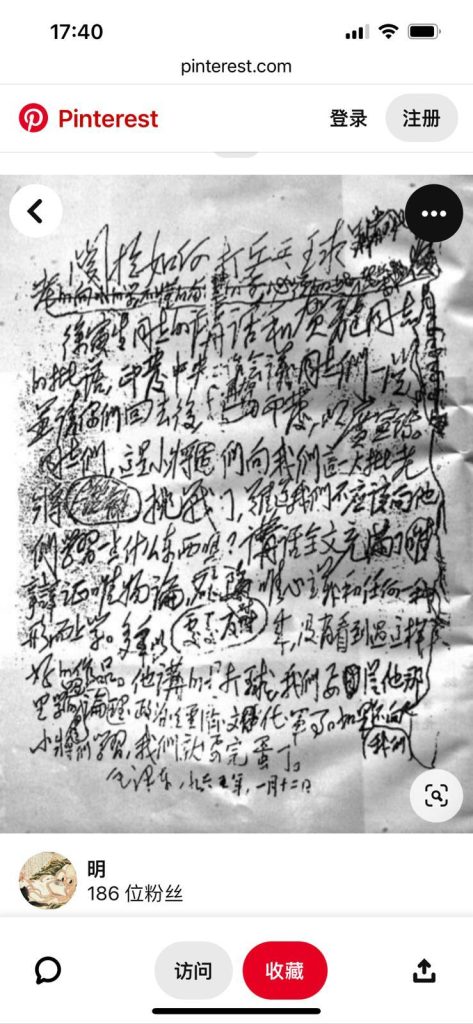
Soon after, hundreds of propaganda articles appeared on the politicized question of how to play table tennis. A brochure of the speeches even saw a print run of 36 million copies. Mao’s directive that had instigated all this only became public knowledge after his death. The magazine “Table Tennis World” (乒乓世界) printed a facsimile of Mao’s handwritten directive in its 4/2019 special issue on the 60th anniversary of China’s first gold medal in 1959. The draft shows how excited he must have been after reading the speeches. Ping pong had provided him with a perfect template for his political goals.
Ping pong shaped the athletic and international image of the young People’s Republic, although neither the transcribed word ping pong nor the sport are based on Chinese traditions. The game and accessories first arrived in the foreign concessions of Shanghai and Tianjin from England via Japan around the 1900s. The Chinese adopted them. Mao, who himself played table tennis as the only sport (swimming came later) as a guerrilla leader and with an Asian penholder grip, nevertheless made it China’s national sport in the early 1950s.
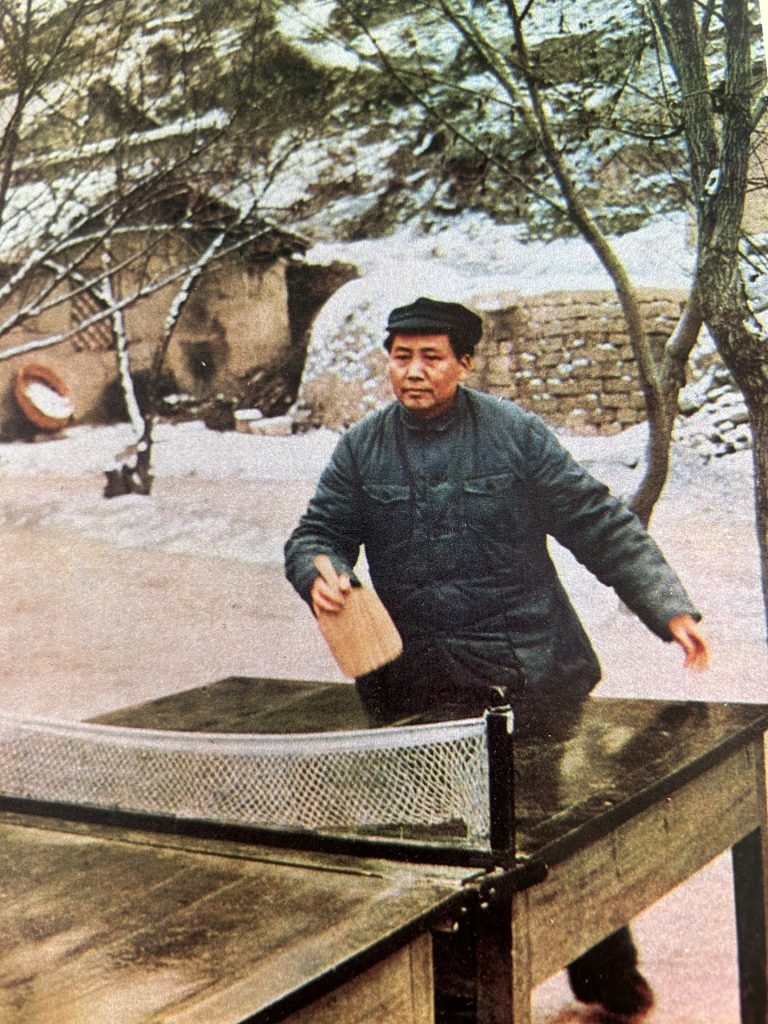
However, it was the International Table Tennis Federation (ITTF) that created the actual ping pong saga. In 1953, it accepted the young People’s Republic as a member – the first professional players were recruited from Hong Kong Chinese. The breakthrough came in April 1959 when Rong Guotuan won China’s first world championship title in the men’s singles at the 25th World Table Tennis Championships in Germany.
Since 1959, the country has been practicing in overdrive, with China’s unrivaled players winning gold medals all over the world. Last week, the women’s team triumphed in South Korea’s Busan at the 2024 ITTF World Team Table Tennis Championships. It secured the world championship title for the sixth consecutive time, the men for the eleventh time. The Swedes only interrupted the men’s winning streak once in 1989, when Jan-Ove Waldener dethroned China with a 5-0 win.
China’s table tennis went through its worst phase during the turmoil of the Cultural Revolution, when, like all sports, it was criticized as a bourgeois and reactionary sport and players and coaches were persecuted. Only 20 months after Mao had romanticized ping pong, all sporting competitions ended. Red Guards drove three national players to suicide in 1968, including the 1959 winner Rong Guotuan. The persecuted sports minister, He Long, also died in 1969.
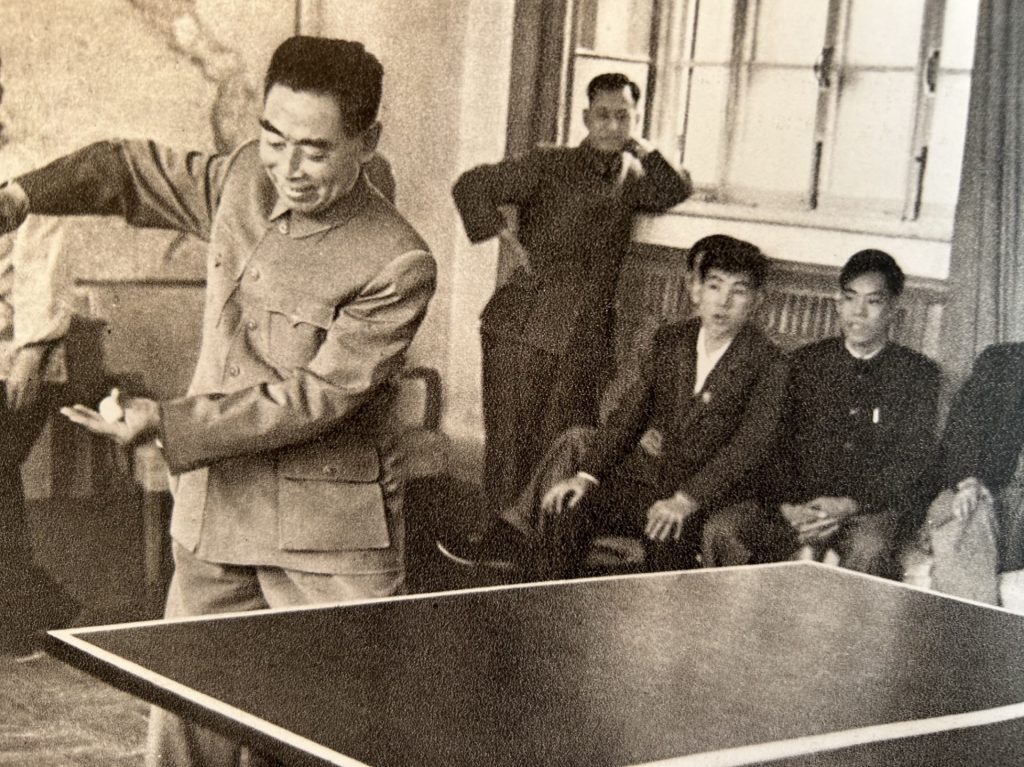
After a six-year hiatus, China’s table tennis had a comeback in 1971 when the country was once again allowed to compete in an international competition in Japan – the 31st World Table Tennis Championships in Nagoya, Japan. The events that would later coin the famous expression “ping-pong diplomacy” (乒乓外交) have often been told.
It all began when US player Glen Cowan missed his team’s return trip after training and hitched a lift on the Chinese players’ shuttle bus. Although Beijing and Washington were bitter rivals at the time, China’s world champion player Zhuang Zedong at least had the courage, after ten minutes of anxious waiting, to greet the American and, with the help of an interpreter, to engage in a friendly conversation. Reporters around the world covered this event. It was the first domino to fall, leading to the visit of a US table tennis team to Beijing in April. Subsequently, Richard Nixon’s historic visit to China with Mao in 1972 was set in motion step by step.
Nixon’s visit to Beijing in 1972 also marked the beginning of China’s so-called panda diplomacy, when Zhou Enlai promised Nixon’s wife a pair of pandas for the USA as a state gift. The bears became ambassadors of international friendship. The state gifts became loans for the purpose of animal and nature conservation as well as research cooperation. To date, Beijing has arranged panda lending and breeding programs with 28 cooperation partners in 20 countries. To date, 68 giant pandas have been bred outside China.
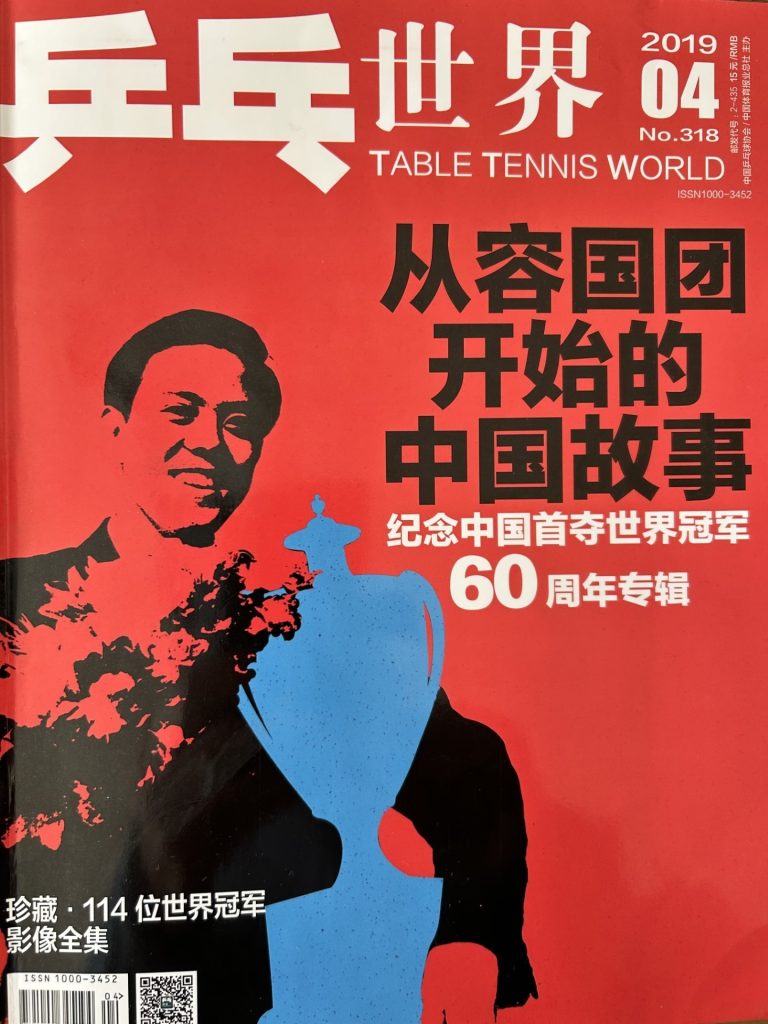
In late 2023, 56 giant pandas from these collaborations still lived in 18 countries. All contracts include the condition that the borrowed pandas and their offspring must be returned. After Beijing began to call back more and more bears in 2023, panda lovers worldwide began to worry that China was planning to end the panda exchange program.
This is not the case. Beijing’s State Council announced in the last week of February that the People’s Republic was “ushering in a new round of international panda cooperation.” Corresponding agreements have been signed with the zoo in Madrid and the zoo in San Diego. Negotiations are currently underway with the zoo in Washington and Vienna’s Schoenbrunn Zoo.
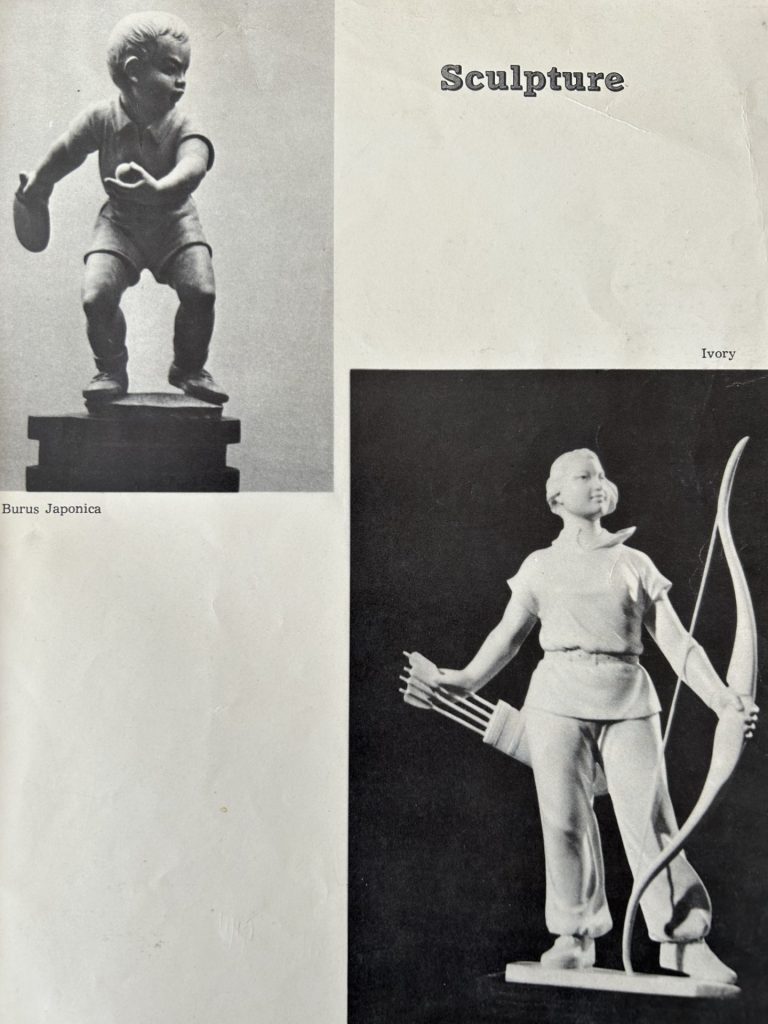
This week, the 93-year-old US lawyer Jerome A. Cohen, a renowned expert on Chinese law, titled his latest blog entry “Return of the Pandas.” Of course, money also plays a role, he revealed. In the 1980s, Cohen proposed a panda leasing agreement to the China Wildlife Association on behalf of the New York Zoo. He offered half a million dollars for a pair of pandas on a limited loan period, but the offer was turned down. But when New York almost doubled the sum, the deal was made.
This global cooperation and research also helped the panda population. When only 1100 pandas were counted in China around 1980, the giant bear species was in grave danger of becoming extinct. Beijing placed its national animals under the highest animal protection. This has paid off with international help. According to the latest figures, around 1900 bears live in the wild again. On top of this, 728 bears have been bred in China’s reserves, zoos and animal parks.
The extinction of the pandas – beloved by all zoo visitors – has been averted. The boredom of table tennis, on the other hand, which is turning more and more into a competition between Chinese teams, can be fatal to public interest. Ping pong fell into disrepute among young Chinese bloggers, especially after the 2008 and 2020 Olympic Games. They mocked it as China’s fossil among sports, doomed to become extinct.
This, in turn, is fitting with the panda, a true fossil in the animal kingdom. China cannot keep relying on its role as a sympathetic ambassador and spectacular table tennis wins to prop up its international image. It needs to find a new soft power. Being dependent on pandas and ping-pong alone can only get you so far.
Vincci Yang has been Head of Sales and Marketing at the Hampton by Hilton hotel chain in China since January. She works at the Shenzhen location. She previously worked for Marriott in Hong Kong and from 2011-2012 for the real estate company Swire at the hotel Opposite House in Beijing.
David Hughes is now CEO of the life and health insurance division for Australia, Japan, South Korea and South Africa at reinsurer Munich Re’s Hong Kong office. He was previously responsible for Asia, excluding China.
Is something changing in your organization? Let us know at heads@table.media!

If you have access to the internet, you’ve probably seen this cat with sad eyes and heartbreaking meow. But did you know that the little feline made famous by billions of memes lives in China? Her name is Guangdang 咣当, and she lives in Nanjing, where her owner found her in a backyard in 2019. At first, the 28-year-old felt overwhelmed by the hype surrounding her pet, as she told Chinese media. Meanwhile, the trained animation designer has even created her cartoon character to add variety to the daily Guangdang content for her 1.4 million Instagram followers.
The “two sessions” of the Political Consultative Conference and the National People’s Congress will begin on Monday and Tuesday next week. We will closely observe the conflicting goals in Chinese politics that the central planning document must resolve this year. Christiane Kuehl kicks things off with a report on the difficult decision of which is the better recipient of state subsidies: the coal industry or renewable energy sources.
Chinese politics generally have a harder time today than during the boom. High growth masks many problems and spares making difficult decisions. Instead of having to choose between two goals, both were often promoted and pursued. Since the real estate bubble popped, however, there are no longer enough resources for such generosity. China’s leadership faces the realities of a large economy.
Just how difficult the decisions are now is demonstrated by the CCP entering the People’s Congress without its Central Committee convening the third plenum. Normally, this meeting sets the guidelines for economic policy at a centralized level. It should have taken place late last fall, but it never happened. Instead, this year’s plans are derived directly from Xi Jinping’s own plans.
Over the past five years, Ursula von der Leyen has made a name for herself as Beijing’s trade policy rival, which she accuses of unfair practices. Next week, the political parties in the European Parliament plan to re-nominate her as their lead candidate at their congress in Bucharest. Amelie Richter retraces the evolution of her China policy.


EU Commission President Ursula von der Leyen is expected to be the Christian Democratic EPP’s candidate for the European elections in June. She intends to have her candidature confirmed in Bucharest next week. Von der Leyen’s de-risking approach has been a defining feature of EU-China relations since 2019, and she intends to continue this program in a possible second term of office.
She has already left her mark on the discussion surrounding the European and German China strategy during her first term of office. “This is the geopolitical Commission that I have in mind, and that Europe urgently needs,” von der Leyen emphasized during the presentation of her program in the EU Parliament in November 2019.
According to Marc Julienne, Director of the Asia department at the French think tank l’Institut français des relations internationales (Ifri) Table.Media, von der Leyen has generally made the right choice with this geopolitical approach. The events of the last five years surrounding the Covid pandemic and the attack on Ukraine have proven her right in her approach, says Julienne.
However, von der Leyen’s approach has “triggered mixed feelings” in the French capital. On the one hand, the concept of risk reduction with regard to China is welcomed there. On the other hand, von der Leyen is considered too US-aligned in Paris, which is traditionally rather Washington-skeptical, says Julienne.
A new chapter is now on the horizon: The US elections this fall. However, the future of the transatlantic coordination on China will only partially depend on the outcome of the US elections, explains Noah Barkin from Rhodium Group and the Berlin office of the German Marshall Fund. “If Donald Trump returns to the White House and starts a trade conflict with Europe, then it is more difficult to envision close collaboration between Washington and Brussels on China.” Barkin is certain, however, that a possible US President Trump will not lead to a significant change in Europe’s approach to China.
“As a former German defense minister, she saw the relationship with China through a security prism from the beginning,” Barkin emphasizes. This is evident, for example, in the Comprehensive Agreement on Investment. The Commission President was “not a fan” of it, and she did not openly express her support for the agreement. Most of the negotiations were held under Jean-Claude Juncker’s previous Commission.
However, von der Leyen did not only inherit the disliked CAI from Juncker but also the now widely known triad of partner, competitor and rival. The Juncker Commission presented this as its China strategy in March 2019. The CAI now seems like a distant memory, somewhere at the back of the EU’s historical mind – while the classification as competitor and rival has shifted more into focus.
Brussels has significantly expanded the EU economy’s defensive capabilities since 2019. The EU has repeatedly made advances that have provoked Beijing’s ire. One example is the planned tariffs on Chinese electric cars, which China considers to be an unfriendly act. Von der Leyen believes they are a necessary means of preventing export dumping. The planned Carbon Border Adjustment Mechanism (CBAM) and the Anti-Coercion Instrument are also a thorn in Beijing’s side.
The brewing friction between the two sides has also been reflected in the recent exchange between Brussels and Beijing, after the Covid-19 pandemic further complicated it: There was no EU-China summit in 2021, because of the rampant coronavirus. In the following year, the format was held in the form of a video call.
Under the shock of the start of the war against Ukraine, Brussels had one issue above all on its list: To win over Beijing as a voice of reason that could influence Moscow. China didn’t want to hear much about this and only wanted to talk trade. The online summit turned out to be a disaster. Both sides seemed ill-prepared for the concerns of the other.
2023 was a decisive year for EU relations under von der Leyen: At the end of March, she was the first Commission President to hold a keynote speech on China, coining the de-risking motto in Brussels. During her visit with Macron in Beijing just a few days later in April, she persisted in her confrontational approach. In December, the first in-person EU-China summit was held in Beijing. Von der Leyen spoke with China’s President Xi Jinping for several hours.
Steven Blockmans, Director of Research at the Brussels-based think tank Centre for European Policy Studies (CEPS), already sees a direction for von der Leyen’s second term in office: “Tensions between China and the EU are bound to rise,” says Blockmans. This will lead the next Commission to put the emphasis in the EU’s approach to the PRC even more on systemic rivalry.

After five years, the EU Commission President has laid the foundations for the geopolitical Commission – but there are still unresolved issues:

In China, the clashing goals of resolute climate action and the continuing hunger for coal are coming to a head. Last year, the People’s Republic deviated from its carbon targets for the first time in years – partly because coal consumption rose by 4.4 percent in 2023.
The complex issues of climate action and energy security will be discussed at the National People’s Congress meeting starting next Tuesday (March 5). After all, both are very high on the priority list of state and party leader Xi Jinping. The NPC is expected to make a clear commitment to expanding renewables, as these are an important driver of growth. However, it is unclear how much the coal industry will be allowed to grow in parallel.
On the one hand, Xi’s efforts to tackle climate change seem ineffective. According to a new study, China’s emissions increased by a whopping 12 percent between 2020 and 2023 due to growing coal consumption. According to Reuters, China approved coal-fired power plants nationwide with a total capacity of 114 gigawatts (GW) in 2023, 10 percent more than in 2022.
On the other hand, China is adding more renewable energy capacity than any other country in the world. According to the National Energy Agency (NEA), China connected more plants to the grid in 2023 than ever before: 216.9 gigawatts (GW) of new solar capacity – more than the total installed capacity of the EU at the end of 2022 – and 75.9 GW of new wind power plants.
This has created a booming new economic sector that competes directly with the state giants in the fossil fuel industries – for state money and benefits. “The conflict of interest between the old and new industries will intensify in climate policy over the next few years,” Nis Gruenberg from the think tank Merics expects. “How the government resolves this conflict will be the decisive joker, as it is for us.”
The state-owned companies in traditional industries continue to invest a lot of money in fossil fuels, Gruenberg told Table.Media. “The big energy companies such as PetroChina or CNOOC are huge socio-economic systems with one to two million connected employees.” The well-being of these giants, which are important for stability, has so far depended on the use of fossil fuels.
However, all parties involved know that they are facing a massive transformation. China’s industry must be “quickly and expensively converted to green energies,” says Gruenberg. For instance, China wants to power steel blast furnaces with hydrogen in the medium term.
And so there are first signs that the coal boom is ending – for example, in the provincial work reports for the NPC. China’s four largest coal hubs, where more than 80 percent of production is concentrated, have no longer issued ambitious targets for higher coal production.
According to Bloomberg, their efforts focus instead “on supporting China’s explosive growth in renewables.” China’s number one coal province, Shanxi, has lowered its annual coal consumption target from over 100 million tons in 2022 to 57 million tons. The provincial government also intends to advance the installation of solar systems on large areas that have become too polluted for agriculture or residential areas due to mining activities.
In line with its self-imposed climate targets, China aims to reach its coal consumption peak in 2025. As a result, growth in coal production could slow to 1.4 percent in 2024, Bloomberg quoted a Guosheng Securities report. This would be the lowest growth since 2017. The current coal boom began after 2017.
However, the plan is not to switch off fossil fuel capacities until the new system of renewable energies and electricity storage is fully operational. “We want to have everything competitive enough to phase out fossil fuels, through the market process. Not command and control,” said government advisor Pan Jiahua in a recent Carbon Brief interview.
In the interview, Pan, vice-chair of the national expert panel on climate change of China, expressed a clear opinion on energy sources: “Fossil fuels are fossils. They are a thing of the past.” Pan called constructing coal-fired power plants and other fossil fuel infrastructure a “waste of money.” Not so with renewables. “Renewables would not require a huge amount of investment in infrastructure.”
“The cleantech sector – i.e., renewable energies or electric cars – has now become a very large industrial sector, accounting for around ten percent of industrial production,” says Nis Gruenberg. “This sector is a growth engine and is now systemically relevant – for China’s economic growth and China as a business location.” Given the massive investments, this will remain the case. So, it is unlikely that this sector will be pushed aside at the NPC. What is more uncertain is how the party leadership will position itself on coal.
The big five electricity producers have a double interest in all of this. “They practically all operate coal-fired power plants and don’t want to lose their investments here,” says Gruenberg. “At the same time, they are also investing in huge solar and wind farms – and are benefiting from subsidies and the rapid development of the sector. These companies are making a clear cost-benefit analysis: As soon as state subsidies for coal are removed, they will transition even faster. The fossil fuel lobby is very heterogeneous. The direction in which it moves is hanging in the balance.”
And politicians will decide on this next week. A new study by the Oxford Institute for Energy Studies (OIES) found that stricter and more specific targets were set in various important environmental and energy policy areas in the second half of 2023. Beijing urges more haste with existing targets. The fact that phrases such as “reducing carbon emissions, reducing pollution, green development, and economic growth” are once again appearing more frequently indicates that these priorities have increased for 2024. The NPC could show whether this is truly the case.
The deal is sealed: Volkswagen and the Chinese EV manufacturer XPeng have concluded negotiations on their future collaboration and signed a cooperation agreement. The two manufacturers will jointly develop electric cars. Two battery-powered models in the compact class are already planned.
In July, Volkswagen secured a five percent stake in XPeng with an investment of 700 million euros. The now finalized cooperation agreement includes the reciprocal use of vehicle and platform parts. The aim is to reduce development costs and achieve “significant synergies.”
The companies want to pool their purchasing activities and jointly develop cars to ensure that new models can be brought to market a third faster. “In the world’s largest and fastest growing EV market, speed is fundamental when it comes to tapping into promising market segments,” said Ralf Brandstaetter, Board Member of Volkswagen AG for China, explaining the move. XPeng CEO Xiaopeng He praised the trusting collaboration in exploring the terms of cooperation.
After Volkswagen’s ID models performed poorly in the Chinese market, the company is now focusing on an ‘In China, for China’ approach to better appeal to Chinese customers. To this end, the Volkswagen Group China Technology Company (VCTC), the Group’s largest development center outside Germany, was founded at the Hefei site. VCTC and XPeng will work together on the new models. jul/rtr
The US government investigates Chinese cars for potential security risks. The White House announced that the focus is on whether the vehicles collect and transmit sensitive data to China. Modern car driver assistance systems use a variety of cameras and sensors. The US government fears that the data collected could fall into the wrong hands.
The Chinese Ministry of Foreign Affairs did not initially issue a statement. Cui Dongsho, Secretary General of the China Passenger Car Association, explained that considering all cars equipped with smart sensors, it would be unfair to target cars from a specific country and impose restrictions.
The USA largely prevents Chinese vehicles from entering its market, partly through high import tariffs. However, Secretary of Commerce Gina Raimondo stated that the government intends to react before the cars are widely available. The US has already targeted Chinese telecommunications companies in the past and labeled Huawei and ZTE as a national security threat. rtr
The US government has banned the transfer of genetic data to China and a number of other countries. The executive order issued by President Joe Biden on Wednesday also prohibits the mass transfer of other sensitive information of US citizens, including geographic, biometric, health and financial data. “Buying data through data brokers is currently legal in the United States, and that reflects a gap in our national security toolkit,” said senior government officials. This represents a security gap. “Countries of concern, such as China and Russia, are buying American’s sensitive personal data from data brokers.”
Experts believe the president’s executive order is aimed at companies such as the Chinese BGI Group. The genetics company is building the China National GeneBank, a state archive containing genetic data on millions of people – not only from China but also from other countries around the world. In 2022, the Pentagon added BGI to a list of companies allegedly working with Beijing’s military back in 2022.
Peter Harrell, a former US National Security Council member, says such data is “extremely high risk” and that there is “little need for that to be processed in China.” BGI, on the other hand, stated that it would respect data privacy and refuse to be driven out of the US market. jul/rtr
Due to forced labor concerns, parts of the international solar supply chain have shifted from China to other countries. For example, polysilicon manufacturers like Wacker in Germany, Hemlock Semiconductor from the US and OCI Malaysia have all increased their deliveries of this solar cell and semiconductor raw material to Vietnam, according to polysilicon market specialist Bernreuter Research on Wednesday. Wacker, Hemlock and OCI Malaysia increased their polysilicon exports to Vietnam by a combined 78 percent to 33,265 tons in 2023.
According to Bernreuter Research, its customers include three of the four largest Chinese solar module suppliers, which have been operating wafer factories in Vietnam for some time: JA Solar, Jinko Solar and Trina Solar. By operating wafer production facilities outside the People’s Republic, China’s manufacturers attempt to circumvent the US import ban on goods from Xinjiang, where forced labor is suspected to take place. Modules bound for the United States must not have any metallurgical silicon or polysilicon from Xinjiang in their supply chain. This is easier to prove at a site in Vietnam.
However, as Bernreuter Research reports, customs statistics show that polysilicon exports from China to Vietnam have skyrocketed from 639 tonnes in 2022 to 4,970 tonnes in 2023. Bernreuter Research said this “raises doubts about the claims of a separate supply chain.”
Conversely, China’s polysilicon imports fell to their lowest level since 2011. Bernreuter Research cites Chinese customs data showing that China’s imports fell by 28.5 percent to 62,965 tonnes in 2023 – even 2,000 tons below the 2011 level. Wacker and OCI Malaysia, in particular, continue to enjoy good business with China. Together, both companies hold a 98 percent market share of polysilicon imports in China. Although China produces large quantities of polysilicon itself, it also requires raw material imports. ck
The EU, Canada, the US and the UK have expressed grave concern over the draft version of a separate security law for Hong Kong. “We are particularly concerned by Hong Kong authorities’ proposal to adopt broad and vague definitions of ‘state secrets’ and ‘external interference’ that could be used to eliminate dissent through the fear of arrest and detention,” reads a press statement from the US Department of State in Washington on Wednesday. The UK’s Foreign Secretary David Cameron fears even more human rights violations. The EU member states plan to present their objections to the Hong Kong government by Friday.
The Hong Kong National Security Law eradicated the freedoms of the southern Chinese metropolis in 2020, despite China having guaranteed them for several decades. The National People’s Congress, i.e. the Chinese parliament, had passed this law. It thus applies to Hong Kong because although Hong Kong is a Special Administrative Region, it is ultimately part of the People’s Republic.
The new legislation is now a project of the pro-Beijing Hong Kong city government and will be passed by the city parliament. This means that the national law with special validity for Hong Kong will now be supplemented by a local law with very similar intentions. This time, the focus is more on the activities of foreigners. Once the law comes into force, the international community in Hong Kong will become more liable to prosecution, for example, for conducting investigations or making political statements.
The government had gathered opinions from business and society until Wednesday. The law is expected to be passed quickly. The existing security law has already largely neutralized the political opposition in the city. fin

Apart from the crispy Peking duck and the food in general, the People’s Republic has two other big “P” up its sleeve: Ping pong and pandas. Often declared dead, both have been image mainstays for decades and are almost the only guarantors of Beijing’s international soft power.
In South Korea’s Busan, China’s ping pong stars have just steamrolled their opponents once again. And rumors that China will no longer allow its pandas to leave the country are fake news: Beijing has refueled its lending carousel for giant pandas and is continuing to turn it at full speed.
In the spring of 2015, a secret Party dossier was openly on sale at a book stall at Beijing’s Panjiayuan flea market. The vendor only wanted 20 yuan for it. As a correspondent, I generally steered clear of internal documents as their possession could be considered espionage.
On 23 January 1965, the Central Committee Ministry of Propaganda had distributed this booklet marked with a warning 机密 as classified material. It was not the age but the mysterious title that I could not resist: “How do you play ping pong?”

I found the answer to this rather bizarre question for a party document on page two in the form of Chairman Mao’s commentary. He wrote it on 12 January 1965 and its content was even more puzzling. Mao demanded that two attached speeches on table tennis be sent to the highest CC comrades and then to the people because they were of utmost importance. One of the letters was from China’s legendary Marshal He Long, who headed the Sports Commission at the time. He urged everyone to thoroughly study the second lecture by ping pong star Xu Yinsheng (徐寅生).
Xu was a gold medalist in 1963. In a long speech, he taught China’s women’s team, which only finished third at the World Table Tennis Championships in Prague, how to win against foreign countries. “First of all, we have to know who we are playing for and how we are playing.” And who the opponent is.
The women should learn from the People’s Liberation Army, who always envision an enemy in mind during training. “I think if we visualize the ping-pong ball as Chiang Kai-shek’s head, we can make every strike even more powerful.” (解放军是带着敌情观念练兵的,我也想如果我们把乒乓球看作蒋介石的脑袋,一板一板打起来该多有力量!) Everything learned must be put into practice, “just as we do when studying Mao’s works.”
This was not the only reason for Mao’s delight. The Chairman gushed about the two speeches and their political implications: “Comrades, I have not read anything so good for years. The talk is full of dialectical materialism and is throughout opposed to idealism and metaphysics. What he [Hsu] talks about is a ball game; what we can learn from it are theory, politics, economy, culture, and military affairs. If we do not learn from the young ‘generals,’ we shall be doomed” (如果我们不向小将们学习,我们就要完蛋了).
The dictator hadn’t gone mad. The lectures on the strategy and tactics of ping pong, how to win it for the glory of China, and how to put individualistic ambitions to one side were just what he needed. He had just launched a new agitation campaign on “dialectical materialism.” Mao was pondering how to let the genie of a new Cultural Revolution out of the bottle against the ossified party bureaucracy and his opponents to secure his autocracy.

Soon after, hundreds of propaganda articles appeared on the politicized question of how to play table tennis. A brochure of the speeches even saw a print run of 36 million copies. Mao’s directive that had instigated all this only became public knowledge after his death. The magazine “Table Tennis World” (乒乓世界) printed a facsimile of Mao’s handwritten directive in its 4/2019 special issue on the 60th anniversary of China’s first gold medal in 1959. The draft shows how excited he must have been after reading the speeches. Ping pong had provided him with a perfect template for his political goals.
Ping pong shaped the athletic and international image of the young People’s Republic, although neither the transcribed word ping pong nor the sport are based on Chinese traditions. The game and accessories first arrived in the foreign concessions of Shanghai and Tianjin from England via Japan around the 1900s. The Chinese adopted them. Mao, who himself played table tennis as the only sport (swimming came later) as a guerrilla leader and with an Asian penholder grip, nevertheless made it China’s national sport in the early 1950s.

However, it was the International Table Tennis Federation (ITTF) that created the actual ping pong saga. In 1953, it accepted the young People’s Republic as a member – the first professional players were recruited from Hong Kong Chinese. The breakthrough came in April 1959 when Rong Guotuan won China’s first world championship title in the men’s singles at the 25th World Table Tennis Championships in Germany.
Since 1959, the country has been practicing in overdrive, with China’s unrivaled players winning gold medals all over the world. Last week, the women’s team triumphed in South Korea’s Busan at the 2024 ITTF World Team Table Tennis Championships. It secured the world championship title for the sixth consecutive time, the men for the eleventh time. The Swedes only interrupted the men’s winning streak once in 1989, when Jan-Ove Waldener dethroned China with a 5-0 win.
China’s table tennis went through its worst phase during the turmoil of the Cultural Revolution, when, like all sports, it was criticized as a bourgeois and reactionary sport and players and coaches were persecuted. Only 20 months after Mao had romanticized ping pong, all sporting competitions ended. Red Guards drove three national players to suicide in 1968, including the 1959 winner Rong Guotuan. The persecuted sports minister, He Long, also died in 1969.

After a six-year hiatus, China’s table tennis had a comeback in 1971 when the country was once again allowed to compete in an international competition in Japan – the 31st World Table Tennis Championships in Nagoya, Japan. The events that would later coin the famous expression “ping-pong diplomacy” (乒乓外交) have often been told.
It all began when US player Glen Cowan missed his team’s return trip after training and hitched a lift on the Chinese players’ shuttle bus. Although Beijing and Washington were bitter rivals at the time, China’s world champion player Zhuang Zedong at least had the courage, after ten minutes of anxious waiting, to greet the American and, with the help of an interpreter, to engage in a friendly conversation. Reporters around the world covered this event. It was the first domino to fall, leading to the visit of a US table tennis team to Beijing in April. Subsequently, Richard Nixon’s historic visit to China with Mao in 1972 was set in motion step by step.
Nixon’s visit to Beijing in 1972 also marked the beginning of China’s so-called panda diplomacy, when Zhou Enlai promised Nixon’s wife a pair of pandas for the USA as a state gift. The bears became ambassadors of international friendship. The state gifts became loans for the purpose of animal and nature conservation as well as research cooperation. To date, Beijing has arranged panda lending and breeding programs with 28 cooperation partners in 20 countries. To date, 68 giant pandas have been bred outside China.

In late 2023, 56 giant pandas from these collaborations still lived in 18 countries. All contracts include the condition that the borrowed pandas and their offspring must be returned. After Beijing began to call back more and more bears in 2023, panda lovers worldwide began to worry that China was planning to end the panda exchange program.
This is not the case. Beijing’s State Council announced in the last week of February that the People’s Republic was “ushering in a new round of international panda cooperation.” Corresponding agreements have been signed with the zoo in Madrid and the zoo in San Diego. Negotiations are currently underway with the zoo in Washington and Vienna’s Schoenbrunn Zoo.

This week, the 93-year-old US lawyer Jerome A. Cohen, a renowned expert on Chinese law, titled his latest blog entry “Return of the Pandas.” Of course, money also plays a role, he revealed. In the 1980s, Cohen proposed a panda leasing agreement to the China Wildlife Association on behalf of the New York Zoo. He offered half a million dollars for a pair of pandas on a limited loan period, but the offer was turned down. But when New York almost doubled the sum, the deal was made.
This global cooperation and research also helped the panda population. When only 1100 pandas were counted in China around 1980, the giant bear species was in grave danger of becoming extinct. Beijing placed its national animals under the highest animal protection. This has paid off with international help. According to the latest figures, around 1900 bears live in the wild again. On top of this, 728 bears have been bred in China’s reserves, zoos and animal parks.
The extinction of the pandas – beloved by all zoo visitors – has been averted. The boredom of table tennis, on the other hand, which is turning more and more into a competition between Chinese teams, can be fatal to public interest. Ping pong fell into disrepute among young Chinese bloggers, especially after the 2008 and 2020 Olympic Games. They mocked it as China’s fossil among sports, doomed to become extinct.
This, in turn, is fitting with the panda, a true fossil in the animal kingdom. China cannot keep relying on its role as a sympathetic ambassador and spectacular table tennis wins to prop up its international image. It needs to find a new soft power. Being dependent on pandas and ping-pong alone can only get you so far.
Vincci Yang has been Head of Sales and Marketing at the Hampton by Hilton hotel chain in China since January. She works at the Shenzhen location. She previously worked for Marriott in Hong Kong and from 2011-2012 for the real estate company Swire at the hotel Opposite House in Beijing.
David Hughes is now CEO of the life and health insurance division for Australia, Japan, South Korea and South Africa at reinsurer Munich Re’s Hong Kong office. He was previously responsible for Asia, excluding China.
Is something changing in your organization? Let us know at heads@table.media!

If you have access to the internet, you’ve probably seen this cat with sad eyes and heartbreaking meow. But did you know that the little feline made famous by billions of memes lives in China? Her name is Guangdang 咣当, and she lives in Nanjing, where her owner found her in a backyard in 2019. At first, the 28-year-old felt overwhelmed by the hype surrounding her pet, as she told Chinese media. Meanwhile, the trained animation designer has even created her cartoon character to add variety to the daily Guangdang content for her 1.4 million Instagram followers.
